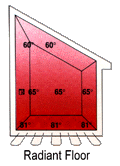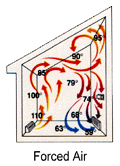Radiant Heat V/S Hot Air
High Heat Demand: The average greenhouse today is heated by hot air. When heating in this manner you must heat the entire volume of space first before you get the desired temperature where your plants are.
Remember: hot air rises--Radiant heat does notů.
What is radiant heat?Hold your hand over a hot cup of coffee and feel the heat. The logical conclusion is that heat rises. Logical maybe, but incorrect! Hot air rises but heat can travel in any direction. That is why you can also feel the heat of the cup if you place your hand to the side of it. Radiant energy transfer is caused by a warm surface pasing its heat onto a cooler surface.
Whenever there is a temperature difference between two surfaces, both surfaces will attempt to equalize. Radiant energy travels through space without heating the space itself. It only turns into heat when it makes contact with a cooler surface. Our human core relies just as heavily on radiant heat transfer as it does on air, yet the majority of heating and conditioning professionals think only in terms of air to temperature. By controlling both the air temperature and the radiant transfer, radiant systems deliver a heating solution that is unsurpassed.


With radiant heat the greenhouse and every object in it becomes a radiator.
Placing radiant tubing in the floor over foil insulation with a set point sensor (a plant sensor), you can maintain a desired temperature within 1 degree at the roots of your plants. Why would you want to heat the ceiling of your greenhouse? The goal is to enhance plant growth. Put heat where it is best utilized-UNDER THE PLANT. Why? Because when you heat your greenhouse the temperature at the ceiling can be 10 to 20 degrees higher than where the plants reside. Your concern is with the temperature at the plant location; not with the void above.
Using hot air heat in your greenhouse is like blowing air into a paper bag. The heated air touches the walls and ceiling of your structure, and is cooled by heat transfer through the glass or plastic, causing the cold air to fall to the floor.
The hot air releases from the bag, just as hot air rushes out when a door is opened. Therefore, the recovery time to reach the desired temperature is very costly.
Energy costs are rising at an all-time high this year: Remember, hot air heat will cost you about twice as much as radiant heat.
Greenhouse Heating Requirements
Heating is a major concern for commercial greenhouse producers. This is due primarily to the costs involved in the purchase and operation of heating equipment as well as the potentially disastrous effects of a poorly designed system. Although solar energy represents a significant factor in greenhouse heating, supplemental systems are a necessity for year-round production.Sources and Methods of Distributing Heat:
Although boilers and traditional hot water heating is becoming increasingly popular among growers. The use of hot water for "under pot heating" has been proven to be extremely effective and efficient. In these systems, water is heated in a modified hot water heater and pumped through an extensive tubing system that is mounted to the bench. The heat is radiated from the tubes and is absorbed by the pots that are placed directly on them. The media in the pot is maintained at a constant temperature, which allows air temperatures to be maintained much lower than with traditional systems. The overall effect is improved plant growth and reduced energy costs.
Thermostats and Controls
There are several types of thermostats and environmental controllers that are available for commercial greenhouse production. Regardless of how sophisticated this equipment is, there are some very basic factors that must be considered if the system is to operate properly.
Sensing devices should be placed at plant level in the greenhouse. Thermostats hung at eye level are easy to read but do not provide the necessary input for optimum environmental control. It is also important to have an appropriate number of sensors throughout the production area. Often times environmental conditions can vary significantly within a small distance.
Do not place thermostats in the direct rays of the sun. This will obviously result in poor readings. Mount thermostats so that they face North or in a protected location. Calculating Greenhouse Heating Requirements
The key to efficiently heating a greenhouse is matching the equipment to the types of crops to be produced. The first step in this process is to determine the heat loss of the greenhouse. Based on this information, the type and capacity of a system may be selected.

